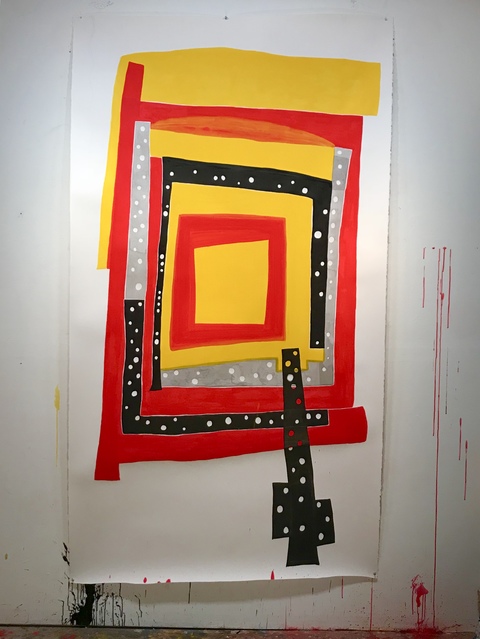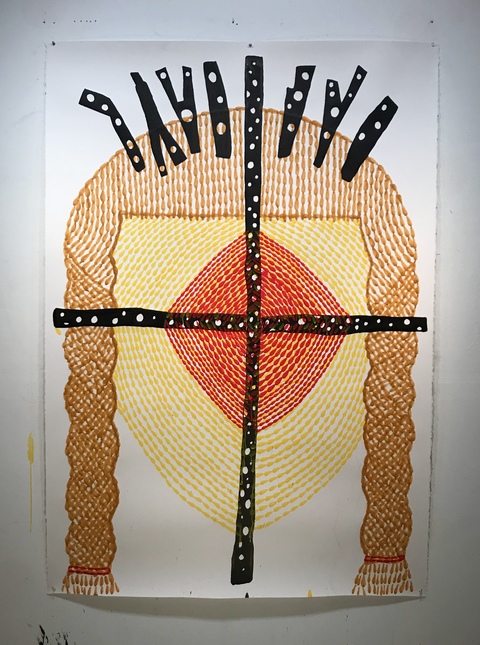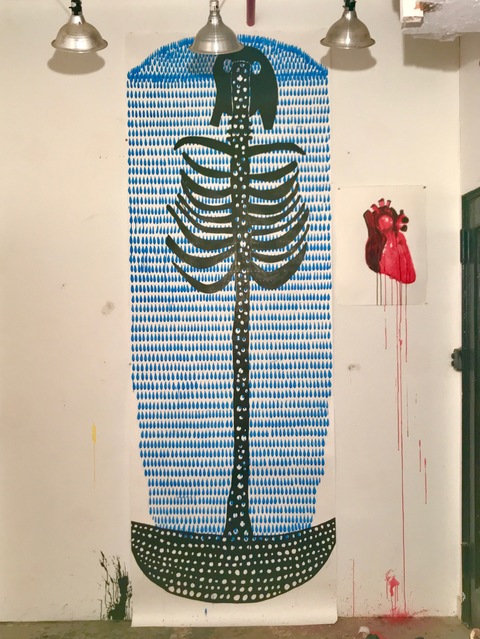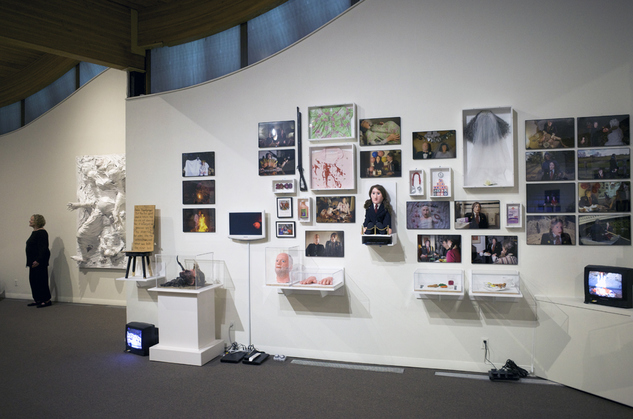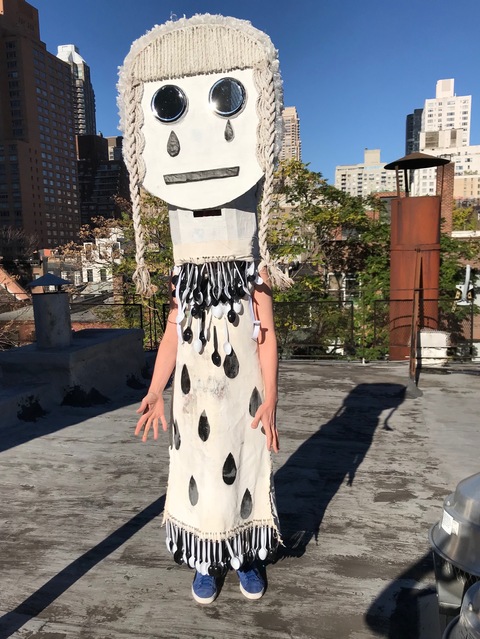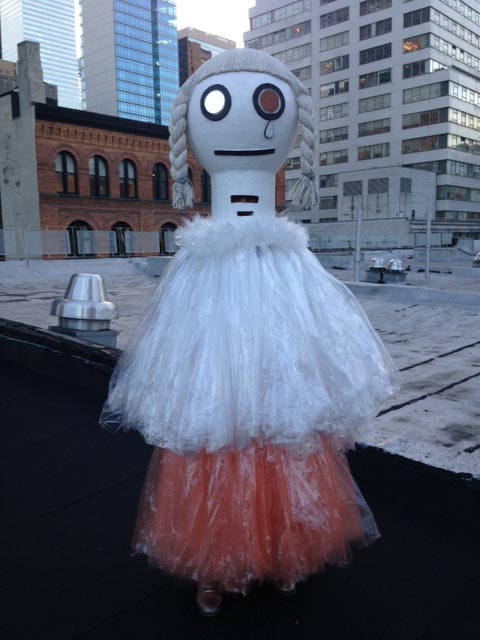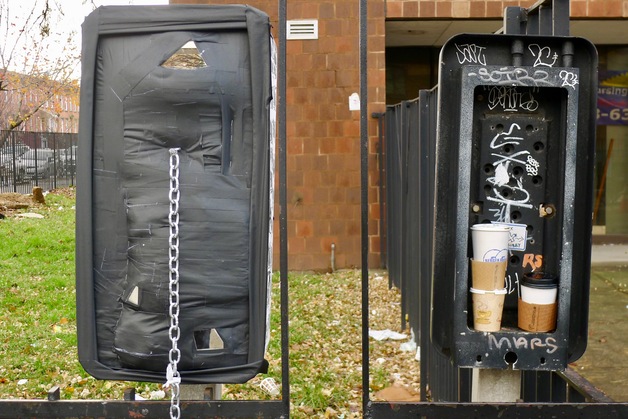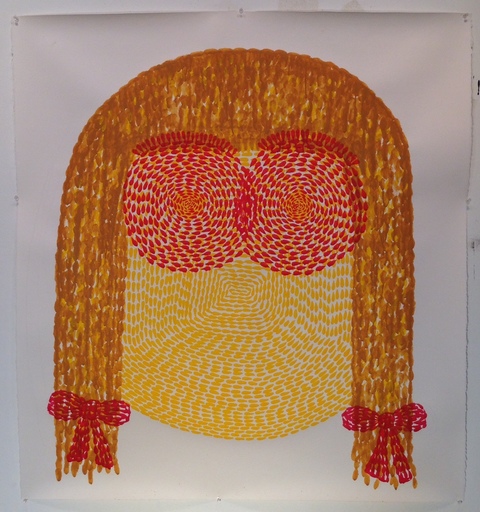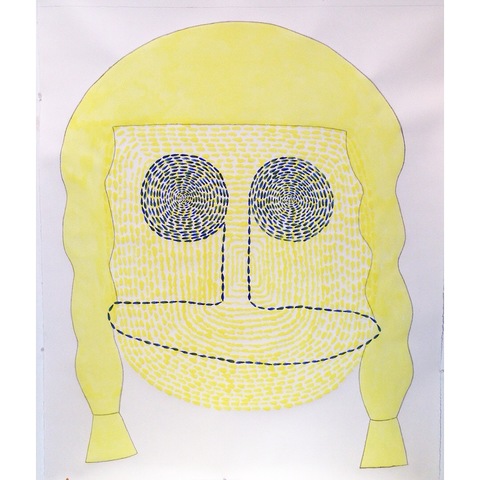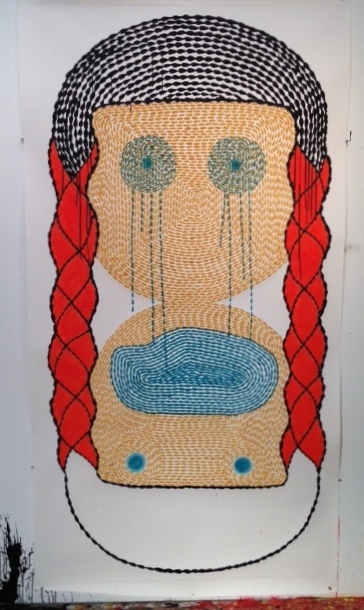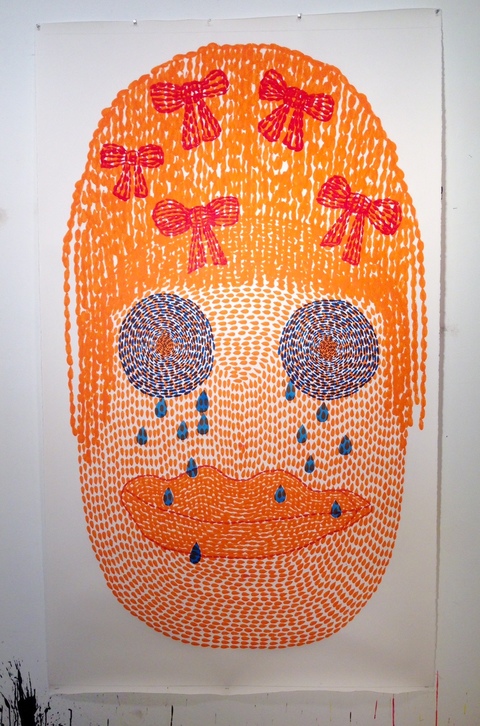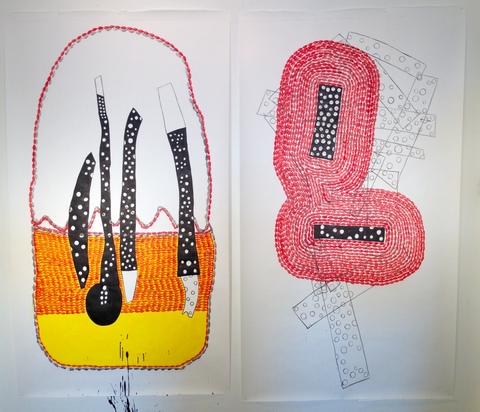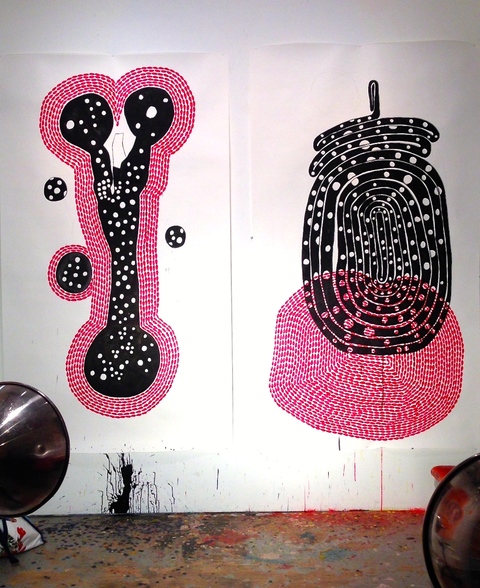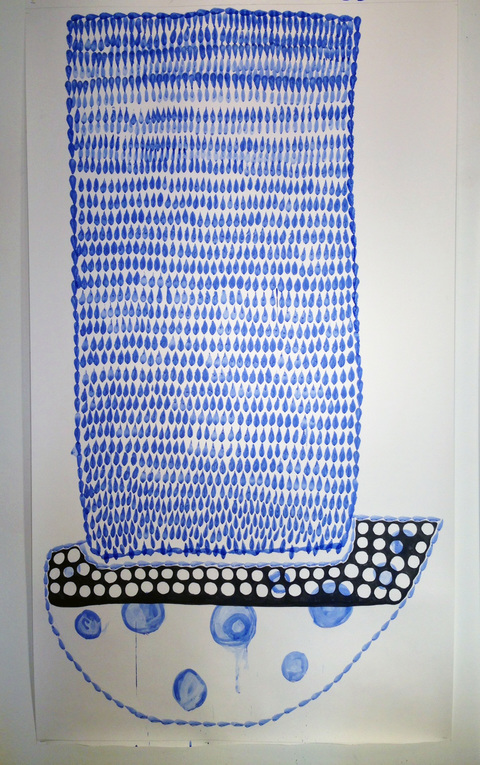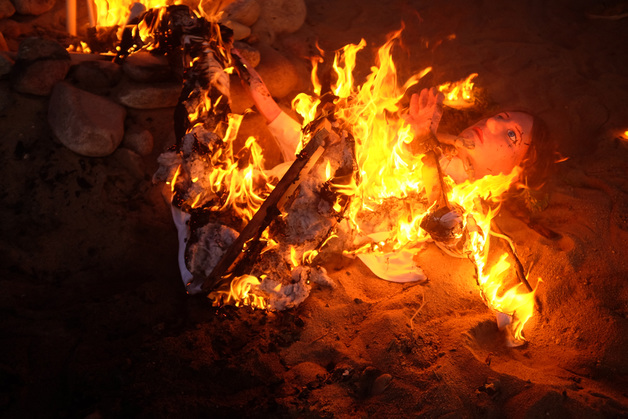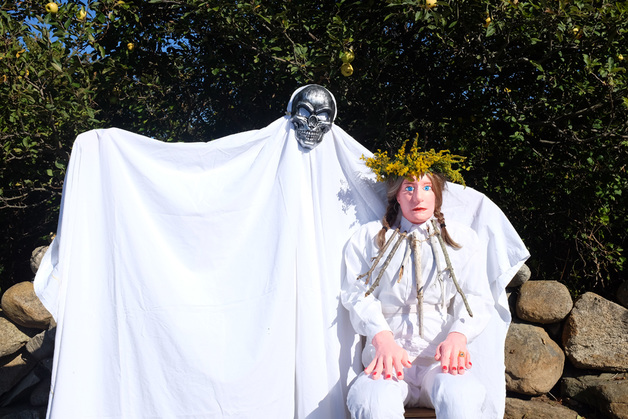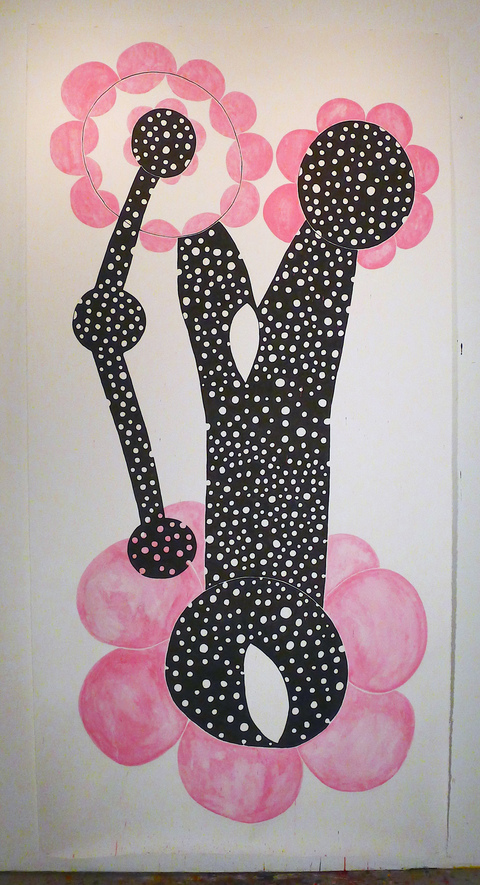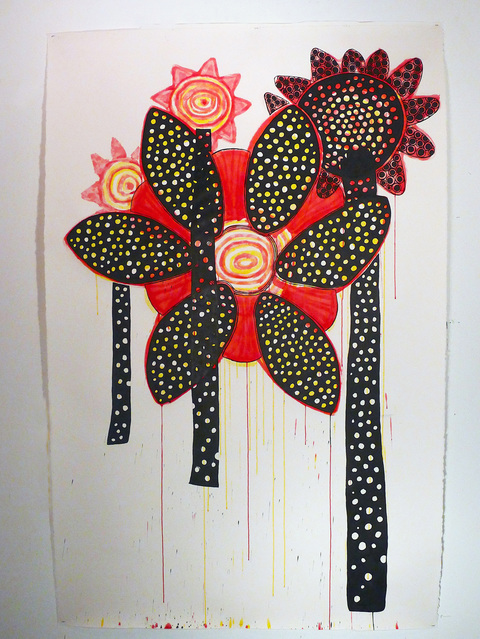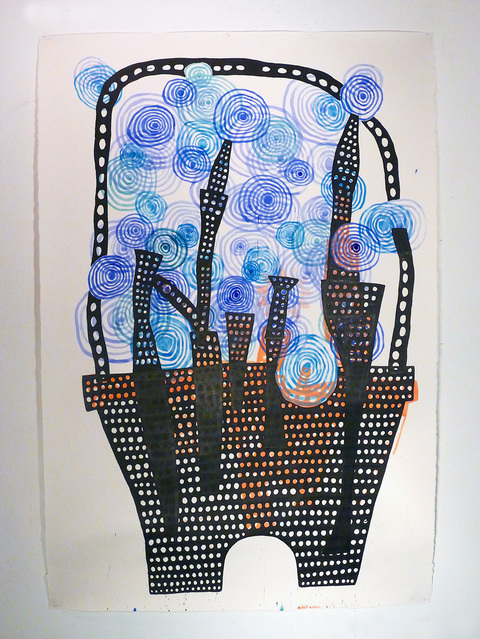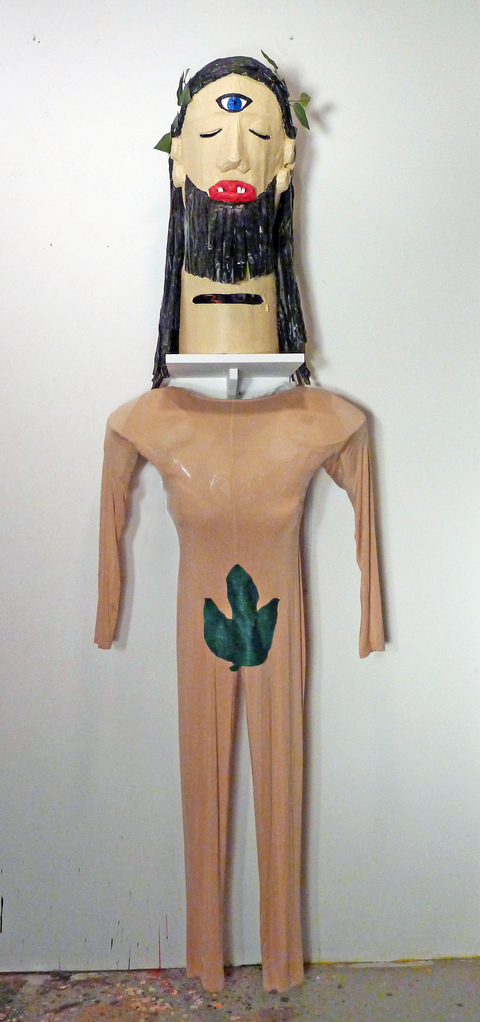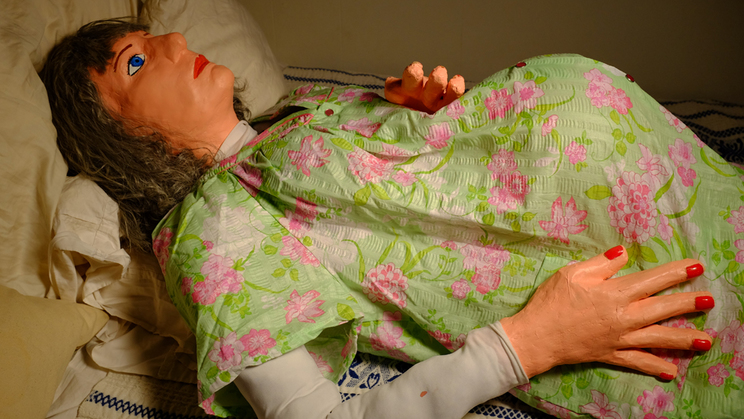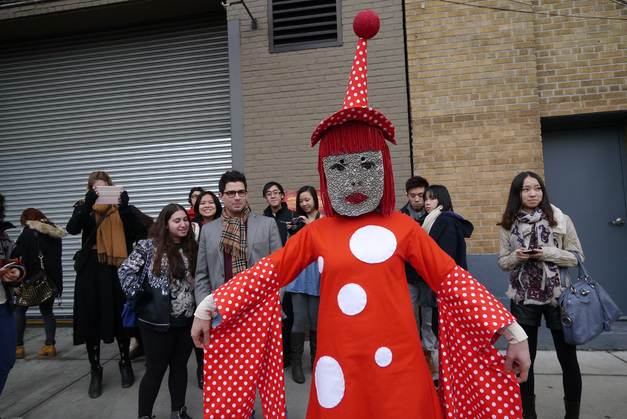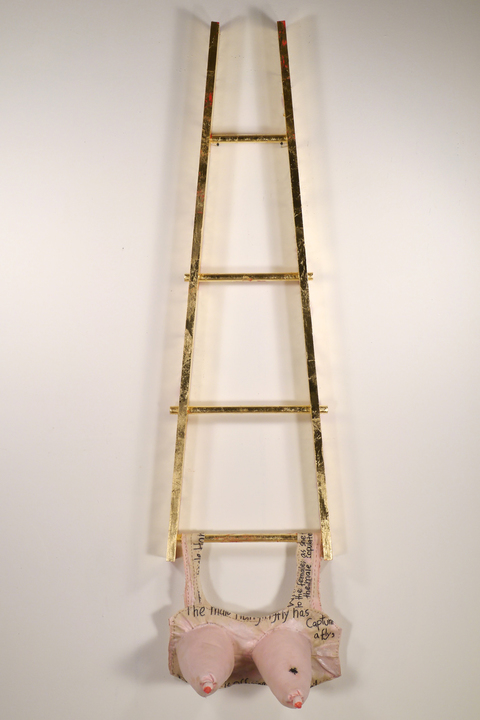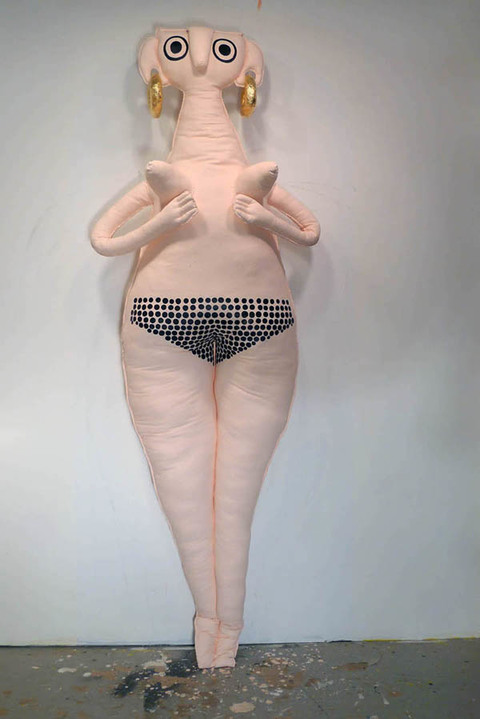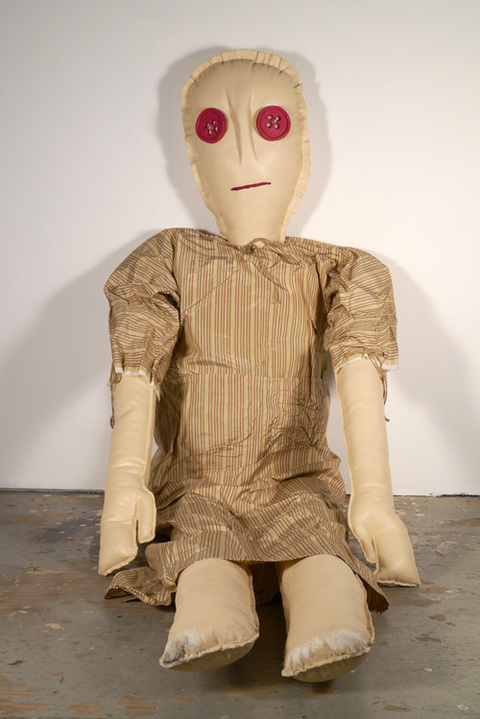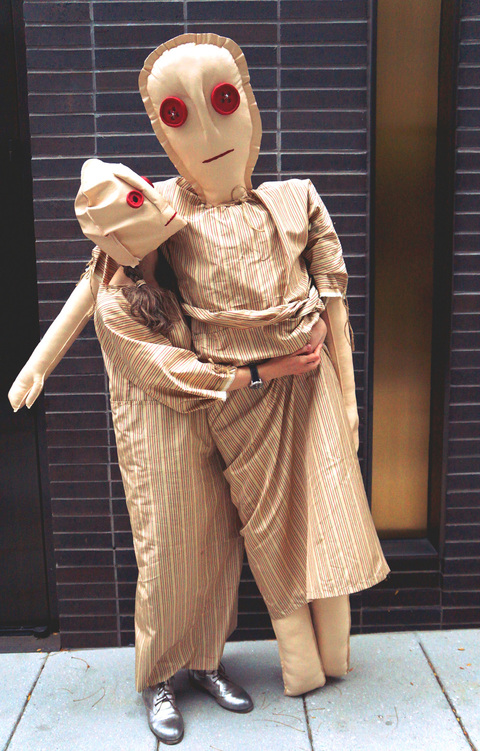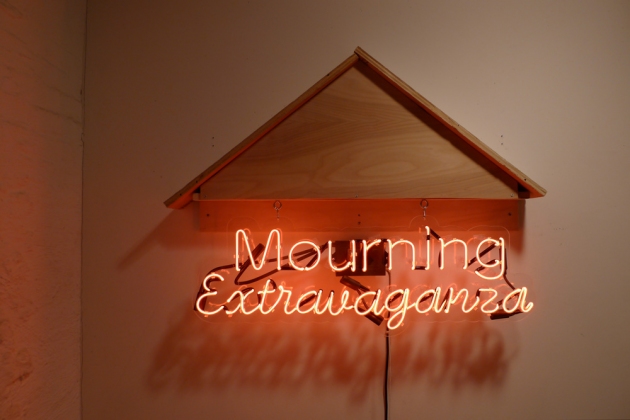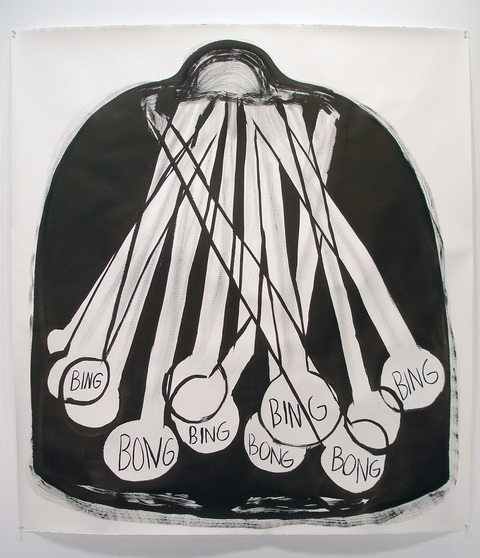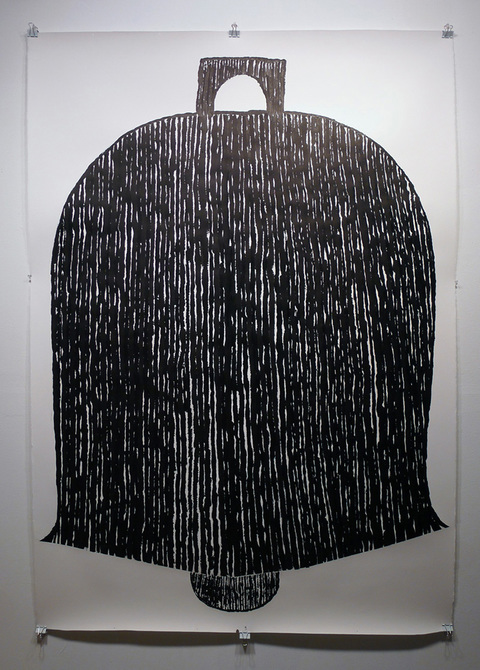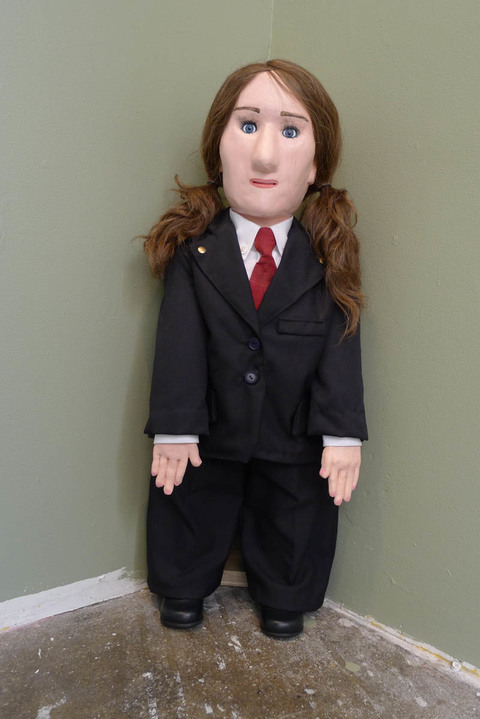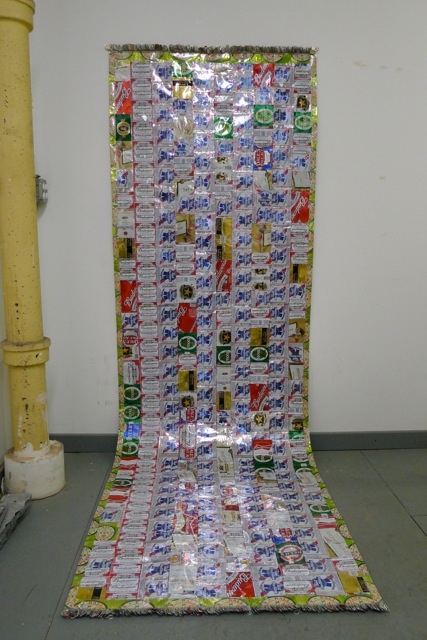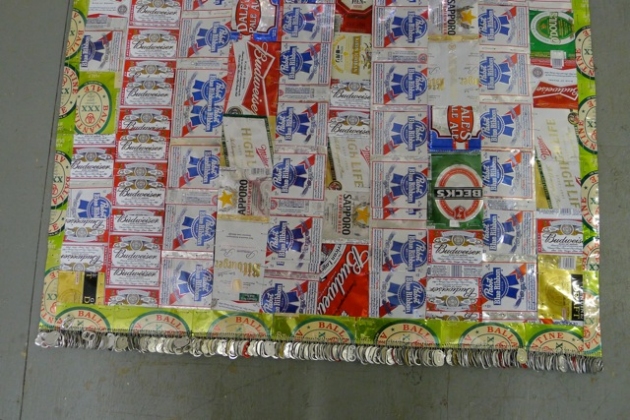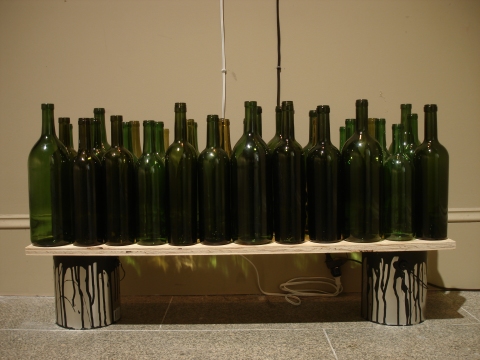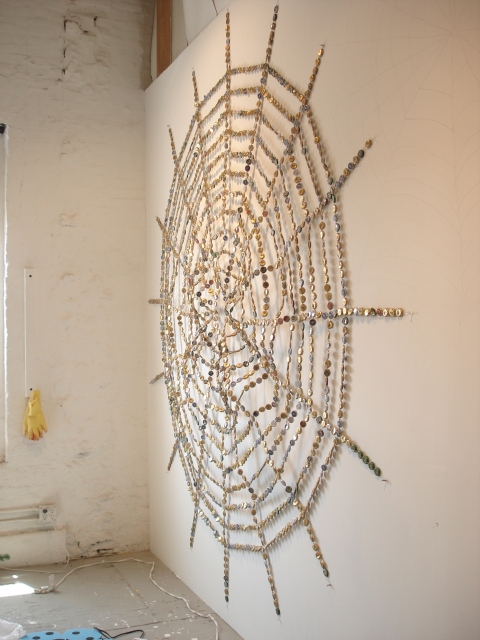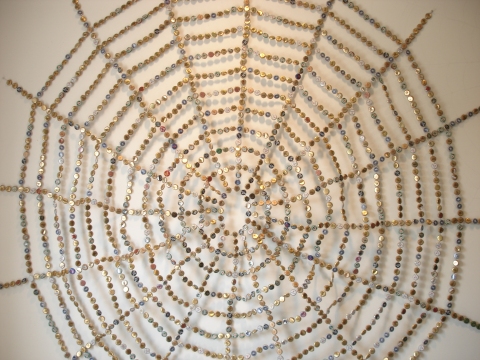Studio Timeline > Studio Time Line
Studio Time Line
Lie With Me and Watch the Stars Die
2025
Machine and hand sewn white cotton sheet and hospital gown.
70 x 30 inches
2025
Machine and hand sewn white cotton sheet and hospital gown.
70 x 30 inches
In January, I started working on my first new piece for this show, which helped me come up with the title for it. I had been saving a very old, worn and discolored white bedsheet I had slept on for years. I started by cutting it up randomly into small squares, then sewing them back together. It created a tile-like effect that felt very fragile, like a weak ghost. I wanted it to be the size of a twin sheet to have the feel of a single person. As I was resewing the pieces of the sheet, the words “lie with me” came to mind. I wanted to sew these three words onto a sheet, and decided to cut the letters from a hospital gown my father had worn while recovering in the hospital last November. After sewing these three words, however, I realized it wasn’t enough; I had to choose which of the two meanings of the word “lie” I wished to convey but loved the fact that it had two very different meanings even though it was spelled the same way for both. So I thought about it some more, racking my brains for the ending, and somehow the full phrase eventually came to me. At first I was worried it might be too hokey or sad. The truth is, though, I don’t know if I’ll ever get tired of referencing stars but nevertheless still feel leery about their possible overuse. Yet the sentence grew on me. And I felt it wasn’t just sad, because stars have a long life. Maybe “Lie With Me and Watch the Stars Die” could even be romantic too. Whatever the case, I hope people will find their own interpretation. But an important thing in all of this is that I found a way of addressing what I had been reflecting on a lot lately: intimacy, aging, illness, and death. Human frailties that we all inevitably meet, have met, or caring for a loved one in the midst of them. This central piece is accompanied by echoing works in the show that open up a larger dialogue on the human condition and relationships, resilience and vulnerability, as well as humor and sadness. The needle and pen. Driftwood and the tin can. Fearless is the imagination on fire.
FLAG: Friendship Love Activism Grace
2023-2024
Met security guard uniforms, wood, metal leaf, wage pins
4 X 6 Feet
2023-2024
Met security guard uniforms, wood, metal leaf, wage pins
4 X 6 Feet
My flag-and-barbell piece for November’s Met employee art show was my biggest art undertaking this year, for which I also created this suit and tie from two small areas of the flag that I liked and had printed on fabric. I affectionately call it my “retirement suit” and wore it to the show’s opening. I’ve always said I’ve been dressing in drag for work for years: it helps me play my role as a security guard. Thank you to Andrea from Soleil NYC Textiles, who helped me refine my design and got the fabric printed, and to Nelly, the seamstress, whose dog bit me at our first meeting, and with whom we both faced a real language barrier but got through it in the end with a lot of smiles.
This piece is my swan song as far as large work-related pieces for the Met employee art show goes. This exhibition opportunity has been the best fringe benefit of my day job, and the greatest introduction to my many talented co-workers and what they make. It has thirty stars for thirty years of my working at the Met. And on the border are wage pins of most everyone who participated in the Met wage transparency pin project—on the right side, updated ones, and on the left, outdated ones.
This piece is my swan song as far as large work-related pieces for the Met employee art show goes. This exhibition opportunity has been the best fringe benefit of my day job, and the greatest introduction to my many talented co-workers and what they make. It has thirty stars for thirty years of my working at the Met. And on the border are wage pins of most everyone who participated in the Met wage transparency pin project—on the right side, updated ones, and on the left, outdated ones.
We Are the Mirror Masks
2023, The Annual Adult School of Dance Showcase at the 92nd Street Y
Cardboard, spray and acrylic paint, mirrors
2023, The Annual Adult School of Dance Showcase at the 92nd Street Y
Cardboard, spray and acrylic paint, mirrors
We Are the Mirror (Dance on a poem by Rumi)
Choreography by: Gloria McLean assisted by Fina, in collaborations with the entire group
Music: Takao Heisho, original score performed live, piano and percussion
Dancers: Narges Anvar, Fina, Douglas Gordin, Emilie Lemakis, Margaret Nakamura
Masks: Emilie Lemakis
Choreography by: Gloria McLean assisted by Fina, in collaborations with the entire group
Music: Takao Heisho, original score performed live, piano and percussion
Dancers: Narges Anvar, Fina, Douglas Gordin, Emilie Lemakis, Margaret Nakamura
Masks: Emilie Lemakis
Love Letter to the World
2023
2023
SOMEDAY
“The Raven Came to Rest”
cardboard, acrylic paint, clocks
ALL
“Eye See All”
cardboard, acrylic paint, clock
OF
“The Crying Planet, Sun and Moon”
cardboard, acrylic paint, balloons, clock
THIS
“Every Minute of Every Hour Around We Go”
cardboard, frozen food boxes, coffee cups, pill bottle, clock parts
WILL
"Must, Shall, Will, Should, Would, Can, Could, May, Might"
cardboard, cardboard tubes, string, crumpled paper, clock
BE
"Birth Clock"
cardboard, cardboard tubes, acrylic paint, first photo ever taken of me after I was born (11:00 pm)
OVER
"The Crying Cat with Olive Branch”
cardboard, newspaper, acrylic paint
(for Valerie)
The sentence “someday all of this will be over” was the title of a site-specific work I created for Pioneer Works in 2021. It consisted of a hand-sewn banner hung from a large cone-shaped tent made from repurposed plastic drop cloth. Housing three videos playing simultaneously on three different TV monitors, the videos depicted various non-narrative fragmented moments I had collected on my smartphone over many years. The piece had to do with the pandemic and the many issues surrounding it that I was processing at the time. Notions of separation, death, and shelter all expanded in their meaning and scope for me during this unprecedented period of mandatory lockdown, which formed the basis for a new personal lexicon that I carried forward into my current unsheltered life. Like a creative clock reset to 12:00, which for 60 seconds marks either a new day beginning or the ending of one, the pandemic constituted a defining moment in time both for me and the world we live in, dividing everything before and everything after. Luckily, I found an inspired space in which to revisit this 7-word sentence. The large-face clock in the main room of the 96th Street branch of the New York Public Library has been the object of my affections for a long time and seemed like a good space in which to create a site-specific piece composed of a series of seven personalized clocks, each displaying one word from this epigram. Almost all of the materials that make up the piece were collected over a period of months and reflect a personal relationship. Many of the cardboard boxes that formed the underlying structure, which I painted over, came from my job at the Metropolitan Museum of Art—as well as discarded frozen food boxes and coffee cups from my studio and balloons from previous art projects of mine. The only unpainted items in the piece are my father’s empty pill bottle and the first photo ever taken of me in the hospital moments after I was born. Over time the meaning of this phrase that spans the piece has shifted for me as we have moved further away from the pandemic. The words now embrace the war in Ukraine, and more recently, the Palestinian-Israeli conflict, as well as climate destruction and many other epidemics that are currently plaguing people in our society. Maybe these words will inspire some comfort because nothing, truly, is forever. Maybe not even time.
“The Raven Came to Rest”
cardboard, acrylic paint, clocks
ALL
“Eye See All”
cardboard, acrylic paint, clock
OF
“The Crying Planet, Sun and Moon”
cardboard, acrylic paint, balloons, clock
THIS
“Every Minute of Every Hour Around We Go”
cardboard, frozen food boxes, coffee cups, pill bottle, clock parts
WILL
"Must, Shall, Will, Should, Would, Can, Could, May, Might"
cardboard, cardboard tubes, string, crumpled paper, clock
BE
"Birth Clock"
cardboard, cardboard tubes, acrylic paint, first photo ever taken of me after I was born (11:00 pm)
OVER
"The Crying Cat with Olive Branch”
cardboard, newspaper, acrylic paint
(for Valerie)
The sentence “someday all of this will be over” was the title of a site-specific work I created for Pioneer Works in 2021. It consisted of a hand-sewn banner hung from a large cone-shaped tent made from repurposed plastic drop cloth. Housing three videos playing simultaneously on three different TV monitors, the videos depicted various non-narrative fragmented moments I had collected on my smartphone over many years. The piece had to do with the pandemic and the many issues surrounding it that I was processing at the time. Notions of separation, death, and shelter all expanded in their meaning and scope for me during this unprecedented period of mandatory lockdown, which formed the basis for a new personal lexicon that I carried forward into my current unsheltered life. Like a creative clock reset to 12:00, which for 60 seconds marks either a new day beginning or the ending of one, the pandemic constituted a defining moment in time both for me and the world we live in, dividing everything before and everything after. Luckily, I found an inspired space in which to revisit this 7-word sentence. The large-face clock in the main room of the 96th Street branch of the New York Public Library has been the object of my affections for a long time and seemed like a good space in which to create a site-specific piece composed of a series of seven personalized clocks, each displaying one word from this epigram. Almost all of the materials that make up the piece were collected over a period of months and reflect a personal relationship. Many of the cardboard boxes that formed the underlying structure, which I painted over, came from my job at the Metropolitan Museum of Art—as well as discarded frozen food boxes and coffee cups from my studio and balloons from previous art projects of mine. The only unpainted items in the piece are my father’s empty pill bottle and the first photo ever taken of me in the hospital moments after I was born. Over time the meaning of this phrase that spans the piece has shifted for me as we have moved further away from the pandemic. The words now embrace the war in Ukraine, and more recently, the Palestinian-Israeli conflict, as well as climate destruction and many other epidemics that are currently plaguing people in our society. Maybe these words will inspire some comfort because nothing, truly, is forever. Maybe not even time.
“Someday All of This Will Be Over” isn’t intended to
merely be a direct, transparent response to the pandemic that came to our town in March 2020, but everything that I made as an artist after that watershed moment seemed to have reset my personal clock to the beginning of a new time period.
For the last several years, starting before the pandemic began, I have passed a small group of various homeless men and women along Madison Avenue and occasionally on benches along Fifth Avenue on my way walking to and from my job at the Metropolitan Museum of Art, where I work as a security guard. Invariably, they would set up in the evening and by 9 in the morning the evidence of their night spent there had vanished. I found their temporary bedrooms inventive, resourceful, functional, and to my eyes, beautiful. Most of the time I never saw the person sleeping inside them--which nevertheless were very personal, individual, and varied in their appearance.
As an artist, I had always had a certain fondness and predilection for using found materials in my work, and the sight of these makeshift tent-like structures greatly moved and inspired me to create the piece I am exhibiting at Pioneer Works. Modeled on their examples, I have similarly built a tent-like structure made from leftover used plastic drop cloth, recently obtained from a small demolition site inside the Metropolitan Museum. Incorporating other found materials, the letters that I sewed onto the “flag” or “banner” were cut out from my old Met uniform pants, and the sticks used in the God’s eyes are pieces of driftwood I collected from the beach and branches from Central Park I found on my way to and from work.
Underneath the “tent” I have set up three TV monitors, placed on available tables and chairs from my studio,
playing an hour-plus-long video, begun at three different times and thus playing out of sync with each other, pieced together from many short clips I shot on my iPhone in the last six years. Many of the clips were shot more recently as part of a long-term ongoing project “On Break: Random Acts of Defiance in the Workplace” I have been producing while on break during my days working at the Met. Most or all of the other clips however were never shot with the intention of producing “art” or of doing anything with them later on, but, as in the case of vernacular photography, rather merely to capture some fleeting moment or scene at the time, for perhaps the sake of better remembering it or satisfying some momentary, short-lived interest or curiosity. But once I began to go through and view them again as a whole, in some cases many years later, I slowly realized that, as fragmentary and disconnected as they were, these short bits and pieces came together to make up a portrait of my life. I wanted to “house” the resulting portrait inside a temporary, makeshift, tent-like structure to point up the temporariness and fragility of life, made all the more apparent in the last year and a half by the pandemic.
merely be a direct, transparent response to the pandemic that came to our town in March 2020, but everything that I made as an artist after that watershed moment seemed to have reset my personal clock to the beginning of a new time period.
For the last several years, starting before the pandemic began, I have passed a small group of various homeless men and women along Madison Avenue and occasionally on benches along Fifth Avenue on my way walking to and from my job at the Metropolitan Museum of Art, where I work as a security guard. Invariably, they would set up in the evening and by 9 in the morning the evidence of their night spent there had vanished. I found their temporary bedrooms inventive, resourceful, functional, and to my eyes, beautiful. Most of the time I never saw the person sleeping inside them--which nevertheless were very personal, individual, and varied in their appearance.
As an artist, I had always had a certain fondness and predilection for using found materials in my work, and the sight of these makeshift tent-like structures greatly moved and inspired me to create the piece I am exhibiting at Pioneer Works. Modeled on their examples, I have similarly built a tent-like structure made from leftover used plastic drop cloth, recently obtained from a small demolition site inside the Metropolitan Museum. Incorporating other found materials, the letters that I sewed onto the “flag” or “banner” were cut out from my old Met uniform pants, and the sticks used in the God’s eyes are pieces of driftwood I collected from the beach and branches from Central Park I found on my way to and from work.
Underneath the “tent” I have set up three TV monitors, placed on available tables and chairs from my studio,
playing an hour-plus-long video, begun at three different times and thus playing out of sync with each other, pieced together from many short clips I shot on my iPhone in the last six years. Many of the clips were shot more recently as part of a long-term ongoing project “On Break: Random Acts of Defiance in the Workplace” I have been producing while on break during my days working at the Met. Most or all of the other clips however were never shot with the intention of producing “art” or of doing anything with them later on, but, as in the case of vernacular photography, rather merely to capture some fleeting moment or scene at the time, for perhaps the sake of better remembering it or satisfying some momentary, short-lived interest or curiosity. But once I began to go through and view them again as a whole, in some cases many years later, I slowly realized that, as fragmentary and disconnected as they were, these short bits and pieces came together to make up a portrait of my life. I wanted to “house” the resulting portrait inside a temporary, makeshift, tent-like structure to point up the temporariness and fragility of life, made all the more apparent in the last year and a half by the pandemic.
I Burn For You
2015
photographs can be found under "Links" on this page
2015
photographs can be found under "Links" on this page
Emilie Dopppelganger, a life-size doll of myself, completes the final chapter of her life. After years of working as a subject in photos, movies, and a play, she retires in a goodbye burning fitting of her compelling and beloved spirit that unfolded before the camera. She has been liberated from her earthly bonds.
Faking It: A Family Portait
2014
Video to watch video it's under "links" on this page
2014
Video to watch video it's under "links" on this page
Two homemade life-size dolls I created of myself and a friend, Emile and Nick Doppelgänger, get married, have sex, and produce a baby.Two years later the family spends a spring afternoon in Central Park, sitting under a cherry tree and miraculously fly a kite.
Trapeze Artist
2014
5 feet x 12 feet x 5 inches
2014
5 feet x 12 feet x 5 inches
"Trapeze Artist" Hand-sewn and stuffed painted canvas, Sharpie , fake fly, wooden ladder, metal leaf. The text on this bra describes the mating habits of the hanging fly. The image of a bra was inspired by a photograph I took of a real fly that had settled on the breast of another sculpture of mine. "Sexpot".
sexpot
2012
2012
Sexpot was produced by drawing an outline with charcoal on two sheets of drop cloth, which were then hand-sewn together, trimmed, and stuffed with fiberfill and black foam. I then painted her with acrylic paint, and adorned her with earrings made from papier-mâché and metal leaf. She is over eight feet tall, and was inspired by Neolithic and ancient Greek artifacts.
Night Flower (for Robert R.)
2010
wood, enamel paint, light bulbs, wine bottles, paint cans
15 x 6 Feet
2010
wood, enamel paint, light bulbs, wine bottles, paint cans
15 x 6 Feet
This piece is dedicated to Robert Rauschenberg, whose retrospective I guarded at the Metropolitan Museum in 2006. His combines inspired me to put my first light bulbs in my work. The “pedestal” of wine bottles and paint cans evokes alcohol’s reputation as a creative fuel.




















































